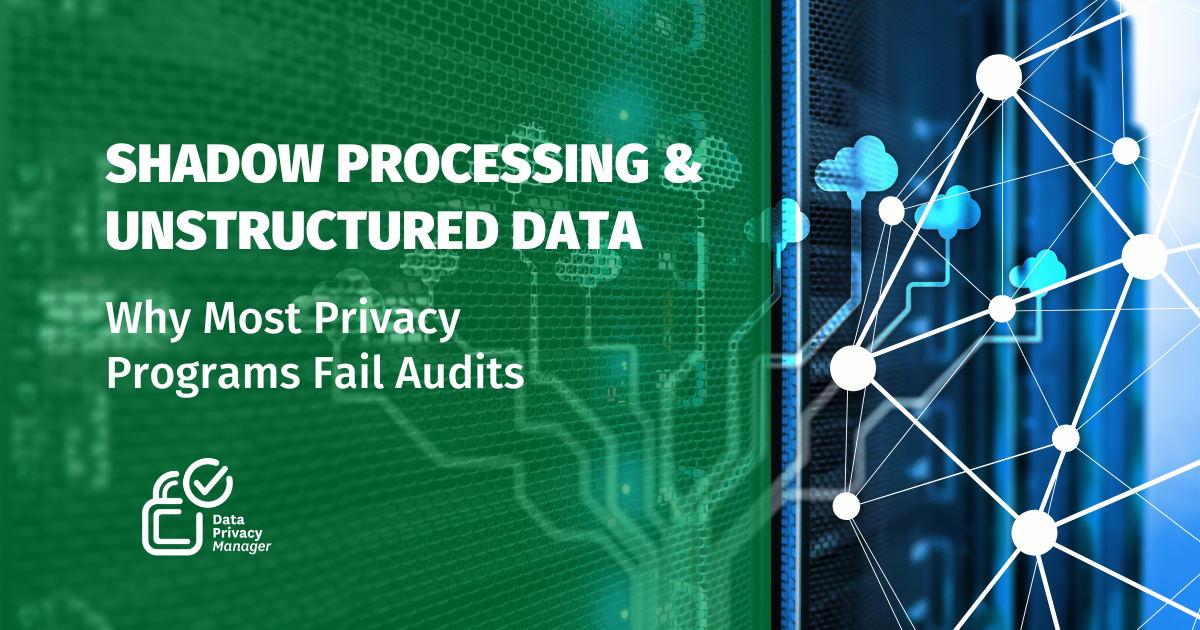In privacy, what you don’t know can hurt you.
Your Records of Processing Activities (ROPA) may be up to date. Your data flows may look airtight. But if your privacy team doesn’t have visibility into all the personal data processed in your organization—including the documents, emails, images and forgotten folders —then your program is built on assumptions, not facts.
That’s where shadow processing and unstructured data come in. Together, they represent the most overlooked privacy risk area and the one least likely to be detected until something goes wrong or a DSAR comes through.
What Is Shadow Processing, and Why Should You Care?
Shadow processing happens when personal data is collected, stored, or used without being formally tracked or approved by your privacy program. It’s not necessarily malicious—it often stems from operational convenience or a lack of awareness.
- A sales rep downloads a full client list to a spreadsheet for quick access.
- HR stores CVs in a private folder outside your documented systems.
- A developer clones production data to a test environment “just for now.”
None of this is in your ROPA. None of it is covered by DPIAs. And most of it never gets deleted.
The Role of Unstructured Data in Shadow Processing
Most organizations are drowning in unstructured data—files, emails, PDFs, Slack messages, scanned documents, and more.
Unlike structured data, it doesn’t sit neatly in a database. It’s scattered across local folders, shared drives, cloud apps, and inboxes.
-
Structured data is organized in predefined formats (tables, fields, rows), typically stored in relational databases (e.g. SQL).
-
Unstructured data lacks a consistent structure, making it harder to search, classify, and govern.
This makes it a perfect breeding ground for shadow processing.
You can’t protect what you haven’t discovered. And unstructured data, by nature, is easy to create but hard to trace:
These aren’t edge cases. This is daily business activity. And unless you have a way to discover and classify that information, you’re exposing your organization to legal and reputational risk.
Manual Mapping Isn’t Enough
Traditionally, privacy teams rely on surveys, interviews, and self-reporting to build their data maps.
But no employee can accurately list every file, folder, or data source that contains personal information—especially when that data is duplicated, renamed, and shared across multiple platforms.
And with unstructured data growing at an exponential rate, the manual approach is not just inefficient—it’s obsolete.
Why Automation Is Non-Negotiable
To manage shadow processing and unstructured data effectively, you need automated data discovery and classification that can:
- Connect to all your data sources—databases, file shares, cloud storage, SaaS tools
- Identify personal data, even in complex or multilingual text formats
- Label and categorize data without relying on human input
- Update your data inventory dynamically as new data is created
This isn’t a “nice to have.” It’s the only scalable way to move from a false sense of compliance to actual visibility and control.

How DPM Data Discovery Helps
Data Privacy Manager was built to solve this exact problem.
Unlike legacy tools that only scan structured databases, DPM Data Discovery scans both structured and unstructured data—including PDFs, Word files, emails, scanned documents, images, and more.
It’s multilingual, context-aware, and designed to identify personal data across any system or document type—without sending any data to third parties.
Once data is discovered and classified, it’s automatically integrated into your privacy program:
- Your ROPA reflects what’s actually happening—not just what’s reported
- DSARs become faster and more accurate
- Privacy risks become visible and actionable
- Shadow processing becomes traceable
- You can delete the data you no longer need —minimizing breach risk, cutting storage costs, and decluttering your systems
Final Thought: Compliance Begins With Awareness
You can’t reduce your data footprint, minimize risk, or operationalize privacy if you don’t know where personal data is.
Shadow processing and unstructured data are the quiet threat in every organization—but they don’t have to stay that way.
With the right tools, you can turn the unknown into something you can manage, govern, and prove—on demand.
Want to uncover personal data in unstructured sources?
Book a personalized demo of DPM Data Discovery and start mapping what’s really happening in your organization.

